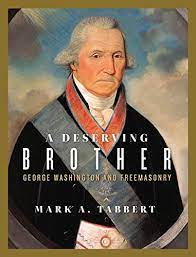

Mark Tabbert is Director of Archives and Exhibits at the George Washington Masonic National Memorial Association. This interview is based on his new book, A Deserving Brother: George Washington and Freemasonry (University of Virginia Press, 2022).
JF: What led you to write A Deserving Brother?
MT: I was hired by the George Washington Masonic National Memorial Association in 2005, I assumed the nearly century-old institution had somewhere along the way collected all there was to know about George Washington the Freemason. After all, the 1752 meeting minute book of the Lodge at Fredericksburg that recorded Washington’s initiation still existed. Most of his correspondence with Freemasons is published, and many artifacts, such as his Masonic apron, are publicly displayed. I was even told by a colleague there was no more evidence to be found.
But soon after starting work at the Memorial I realized my assumptions were wrong. Although most of the evidence of Washington’s Masonic membership was documented, there was no comprehensive analysis of it. I could find no academic paper or publication on the subject on any level. A professor told me the standard work was John J. Lanier’s Washington: The Great American Mason (1922)—a book even I knew was unreliable.
The Memorial Association’s library holdings were even more disappointing. Most of the standard Masonic publications are re-works of Sydney Hayden’s Washington and his Masonic Compeers (1866). Only Julius F. Sachse’s Washington’s Masonic Correspondence (1915) attempted a systematic presentation. Of the scores of secondary articles available, 90 percent were cribbed from these standard works or were outright fiction. The best chronology of Washington’s Masonic activities and correspondence was found on a Masonic research website.
It was not until the Memorial Association’s 2014 Washington’s Birthday Symposium that my disappointments were challenged. One of that year’s speakers, Professor Scott Casper, innocently asked me what book he should read on Washington’s Masonic membership. After patiently listening to my long-winded rant, he responded that I was the obvious solution to my own problem. Stunned by such a charge, it took me a few months before I accepted this fact and set to work.
JF: In 2 sentences, what is the argument of A Deserving Brother?
MT: The book’s purpose is to gather all known evidence of George Washington’s membership in, and interaction with Freemasonry. By presenting the evidence it will affirm his life-long membership in, and support of Freemasonry, while hopefully dispelling numerous misconceptions, tall-tales, and falsehoods.
JF: Why do we need to read A Deserving Brother?
MT: By placing George Washington’s Masonic membership and, after 1778, his patronage of American Freemasonry, this book reveals how both Washington and Freemasonry grew and matured between 1752 and 1799. The book may be seen as a case study that supports both Gordon Wood’s The Radicalism of the American Revolution (1993) and Stephen Bullock’s Revolutionary Brotherhood: Freemasonry and the Transformation of the American Social Order, 1730-1840 (1996).
JF: Why and when did you become a historian?
MT: In the late 1980s and early 1990s I was working on Chicago Board of Trade, but found myself more interested in reading history books. I moved to Pittsburgh to become a high school history teacher, but thankfully found work at the Historical Society of Western Pennsylvania. I soon discovered the history of American fraternalism while pursuing my Master’s Degree in American History and Museum Studies at Duquesne University. In 1999 I became the Curator of Masonic and Fraternal Collections of the Museum of Our National Heritage in Lexington, Massachusetts. In 2005 I published American Freemasons: Three Centuries of Building Communities (NYU Press) and in 2006 started as the Director of Collections at the George Washington Masonic National Memorial in Alexandria, Virginia.
JF: What is your next project?
MT: In the next month I am publishing the Almanac of American Freemasonry, 2 volumes: 1730-1774, 1775-1799. These two books provided a detail account of every known Masonic activity, lodge and publication in North America. I am working on a short history of the George Washington Masonic National Memorial Association which was founded in 1910 and built the George Washington Masonic National Memorial between 1922 and 1932.
JF: Thanks, Mark!